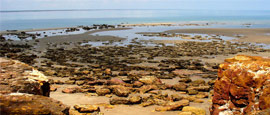This recently renovated museum, housed in a former gun command post, focuses on the bombing of Darwin by the Japanese. Astonishingly, more WWII bombs fell on the city than Pearl Harbor. Displayed are field and anti-aircraft artillery, historical weapons and Japanese swords. The immersive Defence of Darwin Experience tells the story of Darwin's role in the war.
Things to see in Darwin
Tourist offices
Address: 6 Bennett Street, Darwin, Northern Territory, 0800, Australia
Tel: +61 8 8980 6000.
Opening Hours:Mon-Fri 0830-1700, Sat-Sun 0900-1500. www.tourismtopend.com.au
Offering everything from maps and advice to tour and accommodation bookings, plus travel and car hire, this visitor centre is the best place to start your trip.
A multi-million dollar development complete with restaurants, bars, an events complex, sun lawns, wave pools and stinger-free swimming areas, Darwin’s vast new waterfront area has given the city a contemporary feel. There’s still space for tradition though – it’s a short walk to Stokes Hill Wharf, where sunset barramundi and chips remains an essential Darwin experience.
The one-stop shop for everything you need to know about this part of the world includes excellent collections of Aboriginal artwork, arts and crafts from Southeast Asia and the Pacific, a maritime gallery, minerals and insects, a giant stuffed crocodile, and a room set aside for visitors to experience some of the force of Cyclone Tracy.
Helicopters and planes (including a Spitfire and a B-52 Bomber) compete for space with the wreckage of a Japanese Zero at this award-winning museum. Expect engines, relics, uniforms and bombs as displays depict the Territory’s involvement in civil and military aviation from the early pioneers and record breakers to WWII and the jet age.
This place is crowded with crocs; you get to walk over them (on a bridge), hold them (just the little ones) and see them in all stages of life, from hatchlings to adults weighing half a tonne. Croc-feeding sessions take place daily at 10am, noon, 2pm and 4pm. There's a diverse range of other wildlife too.
Not the most uplifting experience, this one-time gaol (jail) tells the tales of those incarcerated here, including many indigenous inmates. Operating from 1883 until 1979, the original building comprises of two blocks containing six cells, a kitchen and a washhouse. The infirmary was added in 1887 and contains the gallows that held the last executions held in the Territory in 1952.
Australia's Parliament House opened in 1994. The building is a lovely example of tropical architecture and also houses Northern Territory Library. Guided tours depart from the foyer every Saturday at 0900 between February and November; and also on Wednesdays at 1030 between May and September. Tours last 90 minutes and are free.
Constructed to protect Darwin's oil supplies from bombardment during WWII, these tunnels, the longest of which stretches 170m (558ft), extend from the Wharf and house an excellent photographic display of wartime images. The tunnels can be found beneath the cliffs of the city, a short walk from the city centre and the Esplanade.
High tide at Doctors Gully sees hundreds of milkfish, mullet, catfish, bream and barramundi come to shore, and the main appeal of a visit here is the chance to feed them by hand. Rays, cod, mangrove jack and diamond fish lurk in the shallows too. The waters are now protected as an official marine sanctuary.
Fancy seeing a crocodile swim over you? Crocosaurus Cove is designed like an aquarium for crocs, even allowing visitors to enter the 'cage of death' and hang out in a croc's territory. There's a reptile enclosure, a twice daily croc feeding show, plus a turtle sanctuary. Entertaining, but a poor second to seeing crocs in the wild.
Do you have any Feedback about this page?
© 2025 Columbus Travel Media Ltd. All rights reserved. No part of this site may be reproduced without our written permission, click here for information on Columbus Content Solutions.








 You know where
You know where